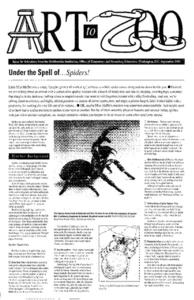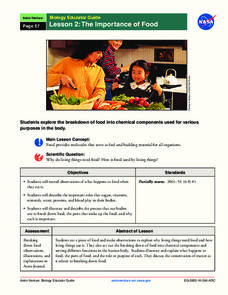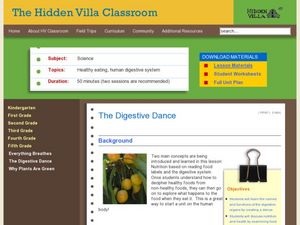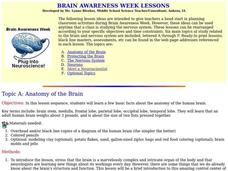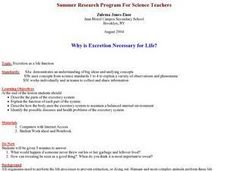Curated OER
Healthy Heart
Students examine the functions of the heart and ways to maintain a healthy heart. In this human body science lesson plan, students listen to Magic School Bus Inside the Human Heart, and diagram the human heart and blood flow. ...
Curated OER
Cell Parts
Students identify parts of a cell. In this biology lesson, students create a simulated cell by using Jell-o, fruit roll ups, raisins, gum drops, and M&M's. Students construct the simulated cell and identify each part.
Curated OER
Seeing in 3D: Interpreting Two-Dimensional Diagrams of Three-Dimensional Objects
Students hone in on their skills at reading diagrams. For this dimensional lesson students collect information on the functions of organs then figure out how all the parts work together.
Curated OER
Under the Spell of Spiders!
Students read about spider body parts, abilities, tendencies, and life cycles. In this Under the Spell of Spiders! lesson, students create mystery creatures that turn out to be spiders. Students catch and observe spiders and insects....
Curated OER
Frogs
Students explore the external and internal structures of an amphibian and how frog anatomy compares to human anatomy. They collect pictures of a frog using a digital camera, create a web page, develop a PowerPoint presentation, and...
Curated OER
Play on Architecture
Students describe how buildings effect them emotionally. They recognize and describe at least five components of a particular building as metaphors for parts of the human body [Footing), heart(h), eye (window), door(mouth), face(facade),...
Curated OER
Tall Tales
Students examine the characteristics of tall tales and how exaggerations are used. They create a character that is larger than life, they brainstorm attributes for their character, before writing a Tall Tale. They plan out their story,...
Curated OER
How Does Radon Affect Human Lungs?
Middle schoolers identify the different parts of the respiratory system of the human body. They work together to complete an activity and worksheet about the effects of radon on the lungs. They research lung diseases if time permits.
Curated OER
The Blood Flow through the Heart and Body
Students discuss the importance of the circulatory system and how drugs and alcohol can affect our bodies. They interact with a CD ROM and then outline their bodies and label the parts of their heart and the blood vessels throughout the...
NASA
The Importance of Food
Pupils make observations while eating food. They act out the process of food breaking down in the body and the roles of various chemical components, such as sugar and protein. It concludes with an activity illustrating the process and a...
Curated OER
Muscular and Skeletal Systems
How do muscles move bones? Find out using a built-in-class model. Pupils construct a hand model with paper and string, then follow a series of directions to explore the movement process. Discover additional information about the muscular...
Curated OER
The Strongest Pump of All
Students examine how the heart functions and the concept of how electrical currents can affect muscle contractions. In this cardiovascular lesson students identify P, QRS and T complexes.
Curated OER
The Digestive Dance
Students read food labels to compare healthy verses non healthy food and then use diagrams to create a poster of the digestive system. In this food lesson plan, students move the food down the digestive track along the digestive system.
Curated OER
The Human Organism
Students identify their feelings and learn constructive ways of handling conflict. In this feelings and conflict instructional activity, students read a story about conflict and identify ways to understand emotions and resolve conflict.
Curated OER
Pathway of Life
First graders explore the circulatory system and its functions. They draw and label the parts of the circulatory system on traced body paper cutouts, and walk on a large chalk outline of a body, following the path of the circulatory system.
Curated OER
Can You Name Parts of the Body?
Students share what they know about the human heart. In this early anatomy lesson, students discuss the location, shape, and importance of the human heart.
Curated OER
Circulatory System Travel Brochures
Students study the human circulatory system including the role of the heart. They design brochures that describe a voyage through the human circulatory system.
Curated OER
Excretory System
Learners discuss what happens to the trash in their home. They talk about what would happen if they didn't remove the trash. Students relate their home trash to the excretory system of their bodies. They label a diagram of the urinary...
Curated OER
Brain Awareness Week
Students explore the brain. In this science lesson, students create a model of the brain and discuss steps taken in order to protect the brain. Students design a container that would protect the brain from injury. Students discuss the...
Curated OER
Nutrition 1: Food and the Digestive System
Students are introduced to how the digestive system works in their body. In groups, they discover they need energy and water to live a healthy life. They discover how the body repairs itself and how it grows. They also examine how...
Curated OER
Circulatory System Design
Students identify the different parts of the circulatory system and their function. They work together to create their own model of the system and use it to determine the rate of blood flow. They answer questions related to their model.
Curated OER
Cardiovascular System Definitions and Study Questions
In this cardiovascular system study question worksheet, learners define 21 words associated with this system. They answer 16 short answer questions related to circulation of blood through the body.
Curated OER
Why is Excretion Necessary for Life?
Young scholars describe and explain the function of each part of the excretory system. They discuss how the body uses the excretory system and identify diseases of the system.
Curated OER
Herps and Humans
Students compare and contrast the similarities and differences between the internal organs of herps--reptiles and amphibians--and humans.



